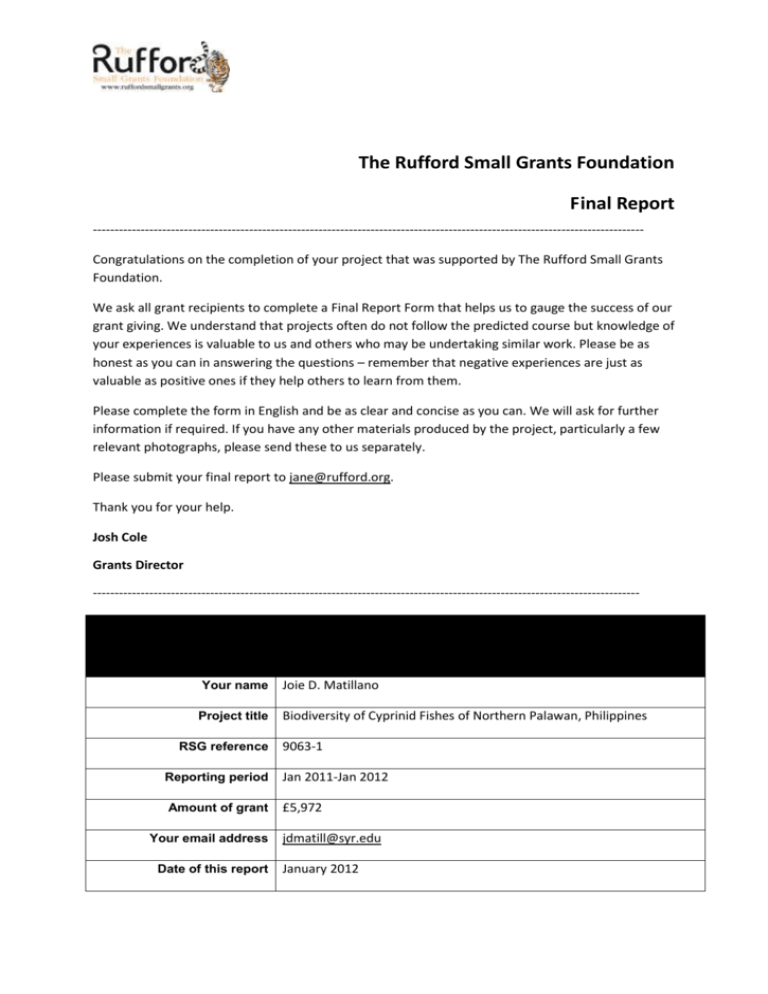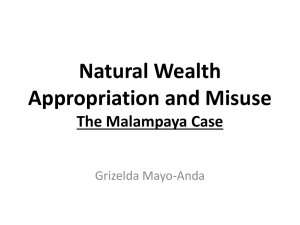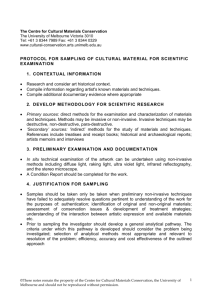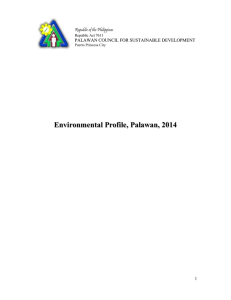Final Report - The Rufford Foundation
advertisement

The Rufford Small Grants Foundation Final Report ------------------------------------------------------------------------------------------------------------------------------Congratulations on the completion of your project that was supported by The Rufford Small Grants Foundation. We ask all grant recipients to complete a Final Report Form that helps us to gauge the success of our grant giving. We understand that projects often do not follow the predicted course but knowledge of your experiences is valuable to us and others who may be undertaking similar work. Please be as honest as you can in answering the questions – remember that negative experiences are just as valuable as positive ones if they help others to learn from them. Please complete the form in English and be as clear and concise as you can. We will ask for further information if required. If you have any other materials produced by the project, particularly a few relevant photographs, please send these to us separately. Please submit your final report to jane@rufford.org. Thank you for your help. Josh Cole Grants Director ------------------------------------------------------------------------------------------------------------------------------ Grant Recipient Details Your name Joie D. Matillano Project title Biodiversity of Cyprinid Fishes of Northern Palawan, Philippines RSG reference 9063-1 Reporting period Jan 2011-Jan 2012 Amount of grant £5,972 Your email address Date of this report jdmatill@syr.edu January 2012 1. Please indicate the level of achievement of the project’s original objectives and include any relevant comments on factors affecting this. Objective Collect voucher specimens of cyprinids from northern Palawan Conduct taxonomic assessment of the cyprinids of northern Palawan Determine the biogeography of northern Palawan cyprinids Not achieved Partially achieved Fully achieved X X X Comments -Efficient sampling during the fieldwork was key to the achievement of this objective. -Technical and logistics support from SUNY ESF, WPU, Cornell University Museum of Vertebrates, the local government of Taytay, and Puerto Princesa City aided in attaining this objective -Local residents in sampling sites were very supportive of our efforts and provided additional support personnel during field samplings -Training of members of the team including the undergraduate students that participated in this project also made the sampling habitat specific. Training facilitated the implementation of proper preservation and cataloguing of the specimens. -This part of the project is still ongoing given the tedious nature of taxonomic studies but results are also very promising, including discovery of new species and genus records. -Access to the different museums in the US that has collection of cyprinids from Palawan is invaluable in fast tracking the taxonomic section of this project. Of particular help are the Field Museum in Chicago, the California Academy of Science, and the American Museum of Natural History in NY. - Efficient sampling of the northern Palawan streams and lakes enabled us to determine the distribution of the cyprinids in northern Palawan. -We have fully determined the distribution of northern Palawan cyprinids. However, the nominal new species are still in the process of description and we cannot ascertain yet their distribution. Assessment of impacts of Tilapia on the native cyprinids X Train undergraduate students and faculty members of WPU in freshwater fish sampling and archival X Provide a draft assessment of the conservation status of northern Palawan cyprinids X Present results of the study to local communities and local leaders and X - The results of our assessment, particularly on the stream populations of Tilapia did not show any current evidence of predation on the native cyprinids, although there is evidence than some streams are already experiencing overpopulation of Tilapia -Assistance of local fishermen proved invaluable in sampling Tilapia in bigger rivers -A continuing research is currently being conducted by one undergraduate student from Western Philippines University, doing a follow up study on seasonal diet preferences of Tilapia specifically in Lake Manguao for 2012 -Number of participants was initially planned to be just 15 individuals but we had to accommodate more attendees due to the positive response of students present during the first orientation meeting for the training. -WPUs support in terms of lecture and laboratory facility and equipment for the training enabled us to accommodate more participants. -Active participation of the students was also key to the success of this training. -Availability of data on distribution and habitat quality enabled us to assess conservation status of northern Palawan cyprinids, particularly the endemics. - Some endemic species we recorded qualifies for Critically Endangered status, while others for Endangered, and the rest are Least Concern or Data Deficient, pending data from southern Palawan. -The discovery of several undescribed species appearing to have restricted distributions may increase the number of species that may qualify for Endangered and Critically Endangered categories pending finalisation of the taxonomic studies. -The preliminary results of this research have been distributed to the local partners, particularly in the local government units. publish the results in peer reviewed journals as well as in popular publications and Produce posters and develop a website of the cyprinids in Palawan X -Active participation of local government units (LGUs) enabled us to reach a broader audience base, particularly those that are in decision and policy making bodies of LGUs and village level leadership -Information education presentations were made in the communities within the sampling sites. Results of this research were presented in two international symposia. -Securing the Conservation Leadership Programme grant will enable us to extend the conservation education programme implemented by the team towards the end of this year, after which all education materials produced will be donated to local schools and universities. - Two papers are currently in preparation for submission to peer reviewed journal - The draft website is under construction and we are just waiting for the approval of annexing this page to the Western Philippines University website. - Posters and photos of the endemic species in the sampling sites have been made, and these were distributed to local communities. 2. Please explain any unforeseen difficulties that arose during the project and how these were tackled (if relevant). There were a few difficulties that we encountered during the implementation of the project. Most of the sampling schedules proceeded as planned, except towards the later part of the project when we have to completely abandon our field sampling plan due to flooding and safety concerns for the team. Nonetheless, we were able to sample the same site after two weeks. Another concern was during the information education campaign drives that we conducted. For local communities, the scheduling was pretty easy and straightforward, however, for the local government units; we had to re schedule several times due to unforeseen events that the local officials have to attend to during the original dates that we intend to meet them. What we did was to become more flexible with our schedule. 3. Briefly describe the three most important outcomes of your project. The three most important outcomes of our project are the following: a) Voucher specimens as basis for taxonomic studies. We have collected voucher specimens of freshwater fishes from the rivers and lakes of Northern Palawan. This collection is the most comprehensive cyprinid collection from Palawan. These collections are also among the best in terms of specimen quality since we were very strict with following the protocols for museum grade specimens. The specimens collected during this project has contributed to the completion of my MS thesis at SUNY ESF, the results of which were communicated to the LGUs as inputs for their biodiversity management plan in the sampling sites. Although taxonomic analysis are still on going and the specimens are still at SUNY ESF collections, the final repository of the specimens will be at the Philippine National Museum, with copies also intended for the California Academy of Science, the Cornell University Museum of Vertebrates, The Field Museum in Chicago, and the American Museum of Natural History in New York City. Once deposited to these museums, these collections will be secured and will be more accessible to other scientists that may conduct further studies on this group of fishes. b) Generation of data on taxonomy, distribution and conservation status of the cyprinids. i. Taxonomy. This project collected two new taxa that were never recorded from Palawan Island before, including new genus record for the Philippines. In addition, the collection of potentially undescribed species of cyprinids from our sampling sites indicates that Palawan freshwaters have been poorly sampled in the past. It also highlights the need for more studies, particularly in areas that we have not covered during this research project. ii. Distribution and Conservation Status. Of the seven species that has been described, our assessment showed that two species of cyprinids qualify for the Critically Endangered status while another three are in the Endangered category. The undescribed species we have collected also shows very restricted distribution, which may eventually increase the number of globally threatened cyprinids in Palawan. The generation of distribution and conservation status data allowed us to provide information to the local government units (particularly Taytay) that will aide them in prioritising areas for wetland conservation. Through our active sharing of ideas and logistical partnership with the local government units in our sampling sites, we have forged good working relationship with the local leaders. In Taytay for example, our school, the Western Philippines University (WPU) is currently in the process of institutionalization of its partnership with the LGU for managing and monitoring the biodiversity of Lake Manguao. This includes establishment of a permanent field station and visitor center in the lake. The municipal government is also in the process of enacting an ordinance that will declare Lake Manguao as locally managed protected area. c) Training of the next generation of Palawan-based field biologists. Before the implementation of this project, only three local residents have conducted freshwater fish studies in Palawan in the past three decades. As such, it was our main goal to train local students and inspire them to join us in our efforts. During this project, 25 undergraduate students of Western Philippines University have successfully completed the fish taxonomy training that we conducted. In addition to this, 15 more students have participated (but did not complete due to scheduling problems) either the field sampling or lectures that we conducted. Of the 25 that completed the training last March-April 2011, five are currently conducting freshwater themed studies as their undergraduate thesis, four of them focusing on different aspects of freshwater fish biology. This is a very good scenario for Palawan, which is facing a dearth of resident field biologists not just in freshwater science but in all fields. Towards the end of this project, three more students have signified their interest in working with us on other aspects of freshwater fish studies in northern Palawan. If these interests could be sustained, an even longer lasting impact to freshwater biodiversity conservation efforts could be expected. 4. Briefly describe the involvement of local communities and how they have benefitted from the project (if relevant). Most of the participation of the local communities during this project was in the information education campaigns, village meetings, and during presentation of our results. However, some of the community members actually volunteered to help us with our field sampling in appreciation of our efforts to survey the fish fauna of their rivers. One of the things that we could say the community actually benefitted from this project is in the promotion of Maoyon River Cruise, a local ecotourism project in Puerto Princesa City. During our field sampling, we helped the local community photo document the sceneries, flora, and fauna along the Babuyan River and provided them both printed and electronic copies. These photos, together with the biodiversity information that we gave them are now being used in interpretation tours along the river. 5. Are there any plans to continue this work? Yes. We have secured additional funding from Conservation Leadership Programme that specifically focused on the conservation of endemic fishes in Lake Manguao. The CLP project is currently being implemented and has picked up on the initial accomplishments of this research project. Some aspects of this project are currently being continued as well by the students that decided to work on freshwater fishes as their undergraduate thesis. In addition, we are also looking for additional funds that can support the continuation of this work in other areas of Palawan that has never been sampled for freshwater fishes to date. We are also working with the local government units where we have found the most diversity of cyprinids with threatened habitats. As a permanent resident of Palawan and a tenured faculty member of Western Philippines University, I personally plan to continue the work that we have started through this project by incorporating it to our lecture, laboratory, and fieldwork activities. As an institution, WPU is actively seeking and building partnerships with the LGUs in northern Palawan to further our involvement in biodiversity research and management, which in many aspects has been helped tremendously by this research project. 6. How do you plan to share the results of your work with others? We have conducted information education campaigns in local communities and LGUs as well as in schools last September to November 2011. This coming May 2012, we are also planning to showcase the uniqueness of freshwater fish fauna of Taytay during their annual celebration of the town fiesta through video and PowerPoint shows in the town plaza. I have presented the results or sections of the results of this research to three international conferences - The Joint Meeting of Ichthyologists and Herpetologists Annual Conference in Minneapolis, Minnesota 6th-11th July 2011, the International Lake Conference in Austin, Texas, USA October 31st-November 4th 2011 and the All Cypriniformes Conference held in Chiang Mai, Thailand January 13th-15th 2012. This study also constituted my MS thesis at SUNY ESF in Syracuse New York. I am currently on the final edits of the journal publication that will be submitted to Zootaxa (Taxonomy and Conservation of the minnow Genus Puntius (Pisces: Cyprinidae) from Northern Palawan, Philippines. In addition, I am also planning for two or potentially three more papers that will deal with updating of the cyprinid biodiversity in Palawan and description of several new species. 7. Timescale: Over what period was the RSG used? How does this compare to the anticipated or actual length of the project? The grant was used from February 2011-January 2012. The original time frame was from January to December 2011 but we had experienced some delays in implementation due to problems with schedules and intermittent weather disturbances. 8. Budget: Please provide a breakdown of budgeted versus actual expenditure and the reasons for any differences. All figures should be in £ sterling, indicating the local exchange rate used. Item Budgeted Actual Amount Amount Difference Comments 1GBP=70.1458PhP Airfare 1,230.00 1,283.00 -53.00 Flight costs changed during the implementation of the project Fuel cost increased during the project implementation Use of four wheel drive vehicle for fieldwork Boat rental and fuel 796.00 822.00 -26.00 248.00 253.00 -5.00 Changes in fuel cost Subsistence 361.00 486.00 -125.00 Accommodation for fieldwork and museum visits (local) Subsistence and accommodation in Chicago and San Francisco (instead of Singapore) 232.00 295.00 -63.00 We had to adjust some of our field expenses to accommodate local community volunteers that helped us and provided security (local village peace and order personnel) during the field sampling. At the same time, we accommodated more student volunteers that participated during the field sampling We accommodated more student volunteers during the field sampling 260.00 310.97 -50.97 Salary 860.00 884.00 -24.00 Three sets gill nets 145.00 140.00 5.00 The visit to Singapore was exchanged for visits to the Field Museum in Chicago, and The California Academy of Sciences where the collection of Palawan cyprinids and other Southeast Asian cyprinids are housed We provided incentives to local security personnel Cheaper materials and labour cost One set beach seine 145.00 138.00 7.00 Cheaper materials and labour cost Dip nets 44.00 27.00 17.00 Cheaper materials and labour cost Tent for camping 120.00 0.00 120.00 Production of information materials Maps 217.00 159.00 58.00 We were able to get free tent, hence the savings Cheaper materials and we got counterpart funding from CLP 145.00 56.00 89.00 Cheaper map cost Miscellaneous field supplies (formalin, alcohol, vials and specimen containers) Aquarium Tank and feeding set up for Tilapia experiment Training workshop on freshwater fish taxonomy 289.00 312.00 -23.00 Cost of 95% ethyl alcohol was higher in Palawan 145.00 58.00 87.00 Counterpart from WPU 290.00 312.00 -22.00 Data Archival 72.00 50.00 22.00 Materials for DNA sample collections Presentation to schools and communities 145.00 140.00 5.00 228.00 286.00 -58.00 We originally intended to have 15 participants but due to high number of interested trainees, we had to accommodate up to 40 people on some of the training days particularly during the lecture courses SUNY ESF provided counterpart materials SUNY ESF provided counterpart materials We had to provide snacks and meals during meetings which usually have more attendants than what we expected TOTAL 5,972.00 6,011.97 9. Looking ahead, what do you feel are the important next steps? We believe that the next crucial steps include follow surveys up with the on-going research initiatives that we have done through this project, which we have identified as most diverse area in terms of cyprinid fishes. In addition, now that more biodiversity data is available for the Lake Manguao area, it is crucial that the locally–led initiative of the government of Taytay to protect Lake Manguao be prioritised and supported by providing more technical and logistic resources, particularly at the grassroots level. We hope to sustain this momentum in order to attain the objective of protecting Lake Manguao as a unique wetland in Palawan. Secondly, we feel that is necessary to continue surveys in other freshwater habitats of Palawan, particularly in the areas where we have never sampled in the past. With just five major rivers and about 15 sampling sites yielding at new genus records and several undescribed species, we expect that more freshwater fish species awaits discovery in Palawan. Last but not the least, we still feel that there is a strong need to educate and train more local students in doing field based biodiversity studies in Palawan, not only dealing with cyprinids and other freshwater fishes but also of other taxa as well that are still wanting biodiversity data. The interest is there, but we do need more people to do the same. We are glad that through our RSG project, we have done our share, which we hope to continue in the immediate future. 10. Did you use the RSGF logo in any materials produced in relation to this project? Did the RSGF receive any publicity during the course of your work? Yes. The Rufford Small Grant Fund was duly given acknowledgement in all materials, presentations and reports produced and presented during the entire duration of the study. 11. Any other comments? We would like to acknowledge the additional funding supports from IdeaWild, and the Conservation Leadership Programme, and Ford International Fellowship Program. These funds provided leverages and allowed us to be more effective and more comprehensive with our field sampling and conservation education activities. We also acknowledge the support of the following institutions: State University of New York College of Environmental Science and Forestry, Western Philippines University, Cornell University Museum of Vertebrates, American Museum of Natural History, Chicago Field Museum, California Academy of Sciences, All Cypriniformes Project, World Wildlife Fund staffs in Taytay, Palawan, and the local government units in our study sites.










